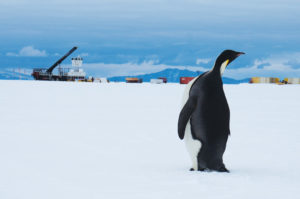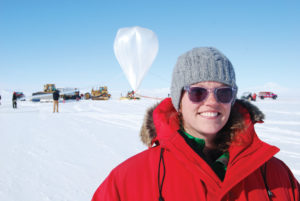
While doing research with NASA’s ANITA project in Antarctica, Katie Mulrey ’08 posted images such as this Emperor penguin visiting the site to her blog for Scientific American.
Katie Mulrey ’08 studies cosmic rays in Antarctica and blogs about it for Scientific American.
As part of a doctoral program, Mulrey is a researcher with NASA’s ANITA collaboration in Antarctica. Now in its third campaign, ANITA (Antarctic Impulsive Transient Antenna) is a balloon that hoists 2½ tons of antennas, communication equipment, cables, and data recording instruments. Once aloft, ANITA detects radio signals from neutrinos and cosmic rays, the highest energy particles in the universe.
When Mulrey left UMW with a degree in physics and mathematics, the New Hampshire native went straight into a Ph.D. program in high-energy particle astrophysics at the University of Delaware. In her first year, she chose ANITA as her research project, in part for the opportunity to travel far away.
“Traveling to remote parts of the world to do science is my cup of tea,” Mulrey said.
The project includes 30 team members representing 10 institutions in the United States and abroad. Mulrey was one of 12 teammates who traveled to McMurdo Station, the largest of the U.S. Antarctic Program’s three stations.
After spending the summer assembling a practice run of ANITA at a NASA facility in Texas, Mulrey and her teammates reached McMurdo in late October. They were given cold-weather gear, including the iconic red jackets, to help combat the frigid temperatures of the Antarctic spring.
“When we first arrived, it was close to zero degrees” Fahrenheit, Mulrey said. And though they visited at the time of year when the sun doesn’t set, it still gets colder in the nighttime, she said.
Once assembled on the massive, icy continent, the ANITA crew got to work wiring electronics, building the antenna array, and setting up communication equipment for the balloon launch. All the while, Mulrey documented ANITA’s progress in “Neutrinos on Ice,” a blog for Scientific American.
With the exception of occasional penguins and continuous daylight, Mulrey said life at McMurdo Station is almost like living on a college campus.
“You live in dorms, have roommates, eat at a cafeteria, and everyone knows each other,” Mulrey said. The U.S. station has about 800 residents and includes a gym, a coffeehouse, bars, and recreational activities.
The balloon launched Dec. 21 and flew to 115,000 feet. At that height it can detect radio waves that reflect off the continent’s smooth ice surface when high-energy particles enter the Earth’s atmosphere. After ANITA’s 22-day flight, scientists feared it would stray over the ocean, so they brought it down.
Now back in the U.S., Mulrey and other scientists wait for the instrument to be recovered. Then they’ll collect its data and spend the next year analyzing it.
“We are very optimistic that we saw a lot of cosmic rays,” Mulrey said. “Whatever we learn from this flight will help us prepare for the next one.”
The ANITA collaboration gave Mulrey the chance to meet other physicists, exchange ideas, and feel confident she’s found her calling.
“It’s solidified in my mind that I really enjoy this type of experiment,” said Mulrey, who plans to complete her doctorate later this year. “And that I’ve chosen the right career for me.”
Neva Trenis contributed to this story.

